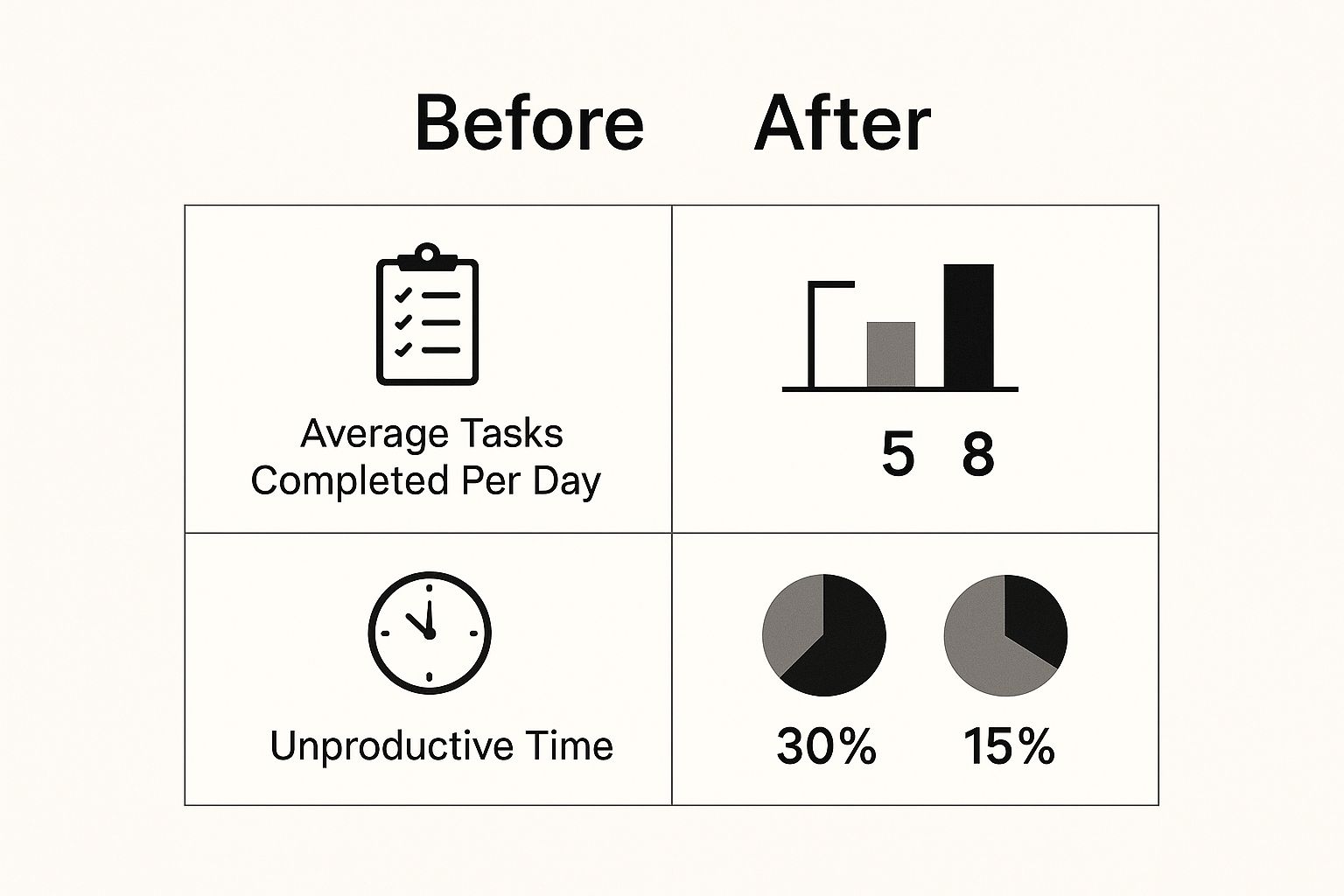How to Improve Workplace Productivity Now

Being more productive at work isn't about logging more hours. It's about getting more impactful results, with less friction. This means building smarter habits, using the right tools, and creating an environment that encourages focused, meaningful effort.
What Real Productivity Looks Like Today

Speak4Me – A modern desk setup with a laptop and notebook, representing an organized workspace.
For a long time, we've confused "being busy" with being productive. Think back-to-back meetings, a constantly pinging inbox, and a to-do list that never ends. That model is outdated and, frankly, broken. True productivity isn't about working harder or longer; it's about working smarter to achieve significant outcomes with clarity and purpose.
The modern workplace demands a complete shift in how we think about our work. Instead of measuring success by the hours someone spends at their desk, smart organizations now look at the quality and impact of what gets done. It all comes down to prioritizing the tasks that actually move the needle and being ruthless about eliminating the rest.
From Busywork to High-Impact Work
A huge part of this is accepting that not all tasks are created equal. To really get a handle on your workload and boost your output, you need solid strategies for task prioritization. The real goal is to identify and fiercely protect time for "deep work"—those complex, high-value activities that demand intense focus and contribute directly to your most important goals.
This shift pays off. As work habits have changed, the average workday has actually gotten shorter, yet overall productivity is up. Why? Flexible work often leads to more focused, efficient time. But it's not all smooth sailing. The average employee is interrupted every few minutes, and it can take over 23 minutes to get back on track after a single distraction.
To truly improve how your team performs, you have to build systems that protect focus. This usually involves:
Mapping out clear workflows to get rid of confusion and wasted time.
Minimizing distractions by setting clear boundaries around communication.
Using tools that simplify tasks, from managing projects to sending quick updates.
Redefining productivity is less about time management and more about attention management. Where you direct your focus determines the value you create.
This is where a tool like Speak4Me can make a huge difference. It helps you articulate ideas quickly and clearly, cutting down on the endless email threads and pointless meetings that chop up your day. Get your communication sorted and start focusing on what really matters. Download Speak4Me free on iOS and see the difference.
Core Pillars of Modern Workplace Productivity
To tie it all together, here's a quick look at the fundamental strategies that form the foundation for a truly productive work environment.
Strategy Pillar | Key Objective | Primary Benefit |
|---|---|---|
Prioritization | Focus on high-impact tasks that align with key goals. | Maximizes the value of time and effort. |
Workflow Optimization | Create clear, repeatable processes for common tasks. | Reduces ambiguity and eliminates wasted steps. |
Distraction Management | Set boundaries to protect blocks of focused work time. | Enables deep work and higher-quality output. |
Smart Tool Adoption | Use technology to automate and simplify administrative work. | Frees up mental energy for creative and strategic thinking. |
By mastering these pillars, you can move away from the "always-on" culture and build a more sustainable, results-driven approach to work.
Mastering Focus and Eliminating Distractions

Speak4Me – A person working on a laptop in a calm, focused environment, highlighting distraction management.
Let's be honest: constant interruptions are the biggest enemy of getting real work done. Every notification, every "got a sec?" from a colleague, every "quick question" via chat—they all shatter your concentration. The worst part is, research shows it takes a surprisingly long time to get back into that deep work zone once you've been pulled out. If you want to get serious about productivity, you have to get serious about protecting your focus.
This isn't just a matter of trying harder. It's about strategically building a fortress around your attention. Think of your focus as a finite resource, because it is. Every time you jump from writing a report to checking an email to answering a Slack message, you're paying a mental tax. This is context switching, and it absolutely drains your energy and kills your momentum on the tasks that actually matter.
Creating Your No-Fly Zone
One of the most effective tactics I've seen is time blocking. It's simple: you schedule blocks of uninterrupted work time directly into your calendar and then treat them like you would any other important meeting. You wouldn't skip a client call, so don't skip your focus time.
I once worked with a marketing team that was constantly up against deadlines. They implemented a collective two-hour "focus block" every afternoon. During that window, all notifications went off, and non-urgent chatter was put on hold. It completely changed their output. This creates a digital 'no-fly zone' that gives everyone permission to just concentrate.
For a deeper dive into sharpening your concentration, check out these excellent tips on how to improve focus at work.
The goal is to make focus the default, not the exception. When you intentionally design your environment for concentration, you stop fighting distractions and start producing your best work.
Streamlining Communication to Reduce Noise
A huge chunk of these daily interruptions comes from messy communication. You know what I'm talking about—those endless email threads where you're just trying to clarify one simple point. Each reply is another ping, another tiny little distraction that chips away at your attention.
This is where adopting smarter communication habits and tools can make a world of difference. Instead of typing out a long, complex email that could easily be misunderstood, what if you could just articulate your thoughts clearly the first time? That’s the key to cutting down on the back-and-forth.
A tool like Speak4Me is perfect for this. It helps you capture nuanced ideas or instructions clearly, ensuring your message lands perfectly without needing a dozen follow-up questions. When you get your communication right from the start, you eliminate the distracting churn that wastes so much time.
Ready to cut through the noise? Download Speak4Me free on iOS and make every message count.
Weaving Technology and AI into Your Workflow
Let's be honest: the right tech can be a game-changer, but the wrong tools just add another layer of digital noise. The real secret to boosting productivity isn't just piling on more software. It’s about thoughtfully bringing in tools—especially AI—that handle the tedious stuff, freeing you up for the creative, high-value work that actually matters.
Instead of getting distracted by the latest shiny app, start by pinpointing your biggest headaches. A project manager, for instance, might grab a tool like Asana or Trello to make it crystal clear who’s doing what, which can practically eliminate those "just checking in" meetings that eat up the day. A writer could use an AI assistant to pull initial research, cutting hours of searching down to a few focused minutes of analysis.
Finding the Right Tools for Your Team
The goal here is to build a tech stack that actually helps your team, not one that gives them a migraine. First, figure out where the friction is. Are you drowning in emails? Are tasks slipping through the cracks? Is finding information a scavenger hunt? Once you’ve named the problem, you can hunt for the right solution.
If you're looking for a solid starting point, we've put together a guide on the best productivity apps out there. It’s worth a look.
The data backs this up, too. Companies that go all-in on AI are seeing real results—a whopping 72% report noticeable gains in productivity. On top of that, 75% of knowledge workers say AI helps them save time and think more creatively.
The best technology doesn’t just make you do old tasks faster. It fundamentally changes how you do them, getting rid of pointless steps so you can focus on what only a human can do.
This image really drives home how much of an impact the right tech can have on your daily grind.

Speak4Me – A chart showing positive productivity trends, such as increased tasks completed and reduced wasted time.
As you can see, even small, smart changes can lead to huge wins, like getting more done each day and cutting down on wasted time.
To help you sift through the options, here’s a quick framework for evaluating tools based on what your team actually needs.
Evaluating Productivity Tools for Your Team
A comparative guide to help teams select the right tools by evaluating them based on key productivity-enhancing criteria.
Tool Category | What to Look For | Example Impact on Productivity |
|---|---|---|
Project Management | Clear task assignment, progress tracking, timeline views | Reduces status meetings and prevents tasks from falling through the cracks. |
Team Communication | Centralized channels, easy file sharing, search functionality | Cuts down on endless email threads and makes finding information instant. |
Note-Taking & Docs | Real-time collaboration, simple organization, AI summaries | Keeps everyone on the same page and turns meeting notes into actionable items. |
AI Assistants | Voice-to-text, message drafting, idea capture | Frees up mental energy by handling routine writing and documentation tasks. |
Choosing the right tool is about matching the feature set to your specific workflow bottleneck. A great communication tool is useless if your core problem is project tracking.
Making Communication Less of a Chore
If there’s one thing that can derail a productive day, it’s clunky communication. We’ve all been there: endless email chains, vague Slack messages, and follow-up meetings just to figure out what someone meant. This is where tools built for speed and clarity really prove their worth. For a deeper dive, checking out some strategies for mastering team email management can make a huge difference for your whole team.
Just think about how much time you burn simply drafting messages, writing up reports, or trying to jot down an idea before it vanishes. An intelligent assistant can help you get those thoughts out quickly and clearly, keeping the nuance without eating up your time.
This is exactly where a tool like Speak4Me becomes indispensable. It’s designed to help you capture complex ideas on the fly and draft clean, concise messages without breaking your stride.
The Real Business Impact of Better Productivity

Speak4Me – A graph with an upward-trending line, symbolizing business growth and profitability from improved productivity.
Let's be honest: "boosting productivity" can sound like corporate jargon for just making people work harder. But it’s not about keeping everyone busy—it's about driving real business growth and shoring up your financial health.
When your teams start working smarter, not just harder, the entire organization benefits. Small, daily wins in efficiency build up over time, creating a serious long-term competitive edge. If you're a leader, understanding this direct connection is key to justifying any investment in new tools or processes.
The link between a more productive team and a healthier bottom line is crystal clear. Greater efficiency means you get more value out of every hour worked, which cuts down on operational costs and directly increases profitability. This is often measured as output per hour, and it’s one of the most fundamental signs of a company's ability to compete and win.
From Efficiency to Profitability
Think about how small, consistent improvements can snowball. When a sales team frees up time by automating administrative work, they can focus on what they do best: talking to clients and closing deals. The impact on revenue is immediate.
Or consider a development team that eliminates a few unnecessary meetings each week. Suddenly, they're shipping products faster, giving the company a crucial head start in the market.
This isn’t just theory. Recent data from the U.S. Bureau of Labor Statistics shows that labor productivity in the nonfarm business sector jumped by 2.4% in a single quarter. That means companies are producing more without adding more labor hours—a textbook recipe for growth. You can dig into these trends yourself on the official BLS website.
A productive workforce isn't a cost center; it's your company's most valuable asset for generating revenue and building a sustainable future. Every improvement in workflow or communication is a direct investment in your bottom line.
Investing in the Right Productivity Levers
To see these kinds of results, you have to start viewing tools and training as strategic investments, not just expenses. A simple app that shaves a few minutes off a daily task for every single employee can save thousands of hours—and dollars—over a year.
This is where technology designed for speed and clarity really shines. For a deeper look, you can find out how to boost your productivity with a text-to-speech app.
A tool like Speak4Me is a perfect example. It’s more than a personal convenience; it’s a strategic asset that helps create a more articulate and efficient team. By giving employees a faster way to capture ideas, draft messages, and review documents, it directly contributes to higher output and a stronger, more competitive business.
Ready to see how better communication can lift your team's performance? Download Speak4Me free on iOS and start turning efficiency into a real business advantage.
It’s All About the People: Fostering a Culture of Well-Being
Let's be honest: you can have the slickest tools and the most optimized workflows in the world, but if your team is burnt out, you’re not going to see results. The human side of performance is what really drives long-term success. Creating a culture that genuinely prioritizes well-being isn’t just a feel-good initiative; it's a core strategy for boosting productivity and keeping your best people around.
When people feel psychologically safe and supported, something amazing happens. They start taking creative risks, collaborating without fear, and bringing their best energy to the table. That foundation of trust is everything, and it’s built day by day through clear communication, consistent recognition, and a real respect for life outside of work.
Stop the Guesswork: The Power of Clarity and Feedback
Few things drain energy faster than uncertainty. When your team doesn't know what’s expected of them or how they're really doing, they spend countless hours just trying to read the tea leaves. As a leader, your job is to cut through that noise with crystal-clear goals and regular, constructive feedback.
Think about it: happy employees are as much as 20% more productive than unhappy ones. A huge part of that happiness comes from simply knowing they're on the right track and that their work is actually being noticed.
This isn’t about micromanaging. It's about creating a predictable, healthy environment where feedback is just a normal part of the process—not a scary, once-a-year event.
I've seen it time and again: the most productive cultures are built on clear, empathetic communication. When people feel heard and understood, they're more engaged, motivated, and pulling in the same direction.
For instance, say you notice a key team member seems checked out. Instead of jumping to conclusions, you could open a conversation by asking about their workload and if they're hitting any roadblocks. This simple, supportive approach builds trust and nips problems in the bud, protecting the whole team's momentum.
Recognition and Connection Make All the Difference
Genuine recognition is probably the most powerful—and most underutilized—motivator we have. It has to be more than a quick "good job." Real recognition is specific. It connects what a person did directly to the team's bigger goals, showing them that their work matters.
Building that positive vibe also means fostering real connections. Here are a few simple ways I've seen work wonders:
Create a "Props" Channel: A dedicated Slack or Teams channel where anyone can give a public shout-out to a colleague for their help or a job well done is an incredibly easy win.
Guard the Off-Hours: Actively discourage emails and messages after work. When leaders model a healthy work-life balance, it gives everyone else permission to unplug, too.
Start Meetings with a Human Moment: Before diving into the agenda, spend just two minutes asking how everyone's weekend was. It's a small gesture that reminds everyone they're more than just their job title.
At the end of the day, a supportive culture boils down to thoughtful communication. Leaders have to deliver feedback and instructions in a way that minimizes confusion and builds people up. If you struggle to find the right words, a tool like Speak4Me can help you articulate complex ideas with more clarity and care, making sure your message lands the way you want it to.
Ready to build a more connected and productive team? You can Download Speak4Me free on iOS and start communicating more effectively today.
Answering Your Top Workplace Productivity Questions
Even with a solid game plan, you're bound to run into a few questions as you start making changes. Let's tackle some of the most common ones I hear from people trying to get a real handle on their team's productivity.
Where Do I Even Begin? What’s the One Thing I Can Do Today?
If you do just one thing, start with a distraction audit. It's simple but incredibly revealing. For one week, just keep a running log of everything that pulls you away from what you're trying to do. Every notification, every "quick question" from a colleague, every meeting that could have been an email—write it all down.
By the end of the week, you'll have a crystal-clear picture of your top 3-5 focus-killers. Don't try to fix everything at once. Just target those top offenders. Maybe that means turning off desktop notifications for good, or blocking out "no-meeting" time on your calendar. Tackling these specific, high-impact issues first will give you the biggest win, fast.
Once you get a handle on the noise, the tools you use for communication suddenly become way more effective. You start using them deliberately, not just reacting to a constant stream of pings.
How Do I Boost My Team's Productivity Without Becoming a Micromanager?
This is a big one, and the answer is to shift your focus from activity to outcomes. Your job isn't to watch over everyone's shoulder; it's to set clear, measurable goals and then get out of the way. Give your team the autonomy to figure out how to get there.
Your role as a leader is to be a roadblock remover. Provide the resources they need and make sure communication lines are open. Brief daily check-ins (like a stand-up) can be great for this, as long as the focus stays on progress and what’s getting in the way—not a minute-by-minute rundown of what everyone is doing. This builds trust and empowers people to own their work.
When team members have tools that let them share a quick, detailed update on their own terms, it builds that trust naturally. It’s often much clearer and more efficient than a formal email chain, and it empowers them to communicate without feeling like they're being watched. Speak4Me assists with this by making it easy to send clear, concise updates without typing.
Are All These Productivity Tools Really Worth the Money?
They can be, but only if you're strategic about it. The goal isn't to collect a bunch of shiny new apps. It's to find a specific bottleneck in your workflow and choose a tool designed to solve that exact problem.
For instance, if your team is drowning in meetings, a tool that helps you communicate better asynchronously is a fantastic investment. If you find everyone is burning hours just trying to draft emails and reports, an app that speeds up that writing process will pay for itself almost immediately.
Think about how much time your team spends just trying to get their thoughts down in writing. An intelligent assistant can help you capture and draft ideas in a fraction of the time, handing you back a huge chunk of your day. This is precisely the problem a tool like Speak4Me was built to solve—helping you get your ideas out clearly and quickly.
The trick is to find a real pain point and solve it, not just to add more software to the pile.
Ready to make communication your team's superpower? With Speak4Me, you can cut down on wasted time and focus on what truly matters.
Try Speak4Me for Free
